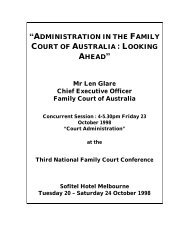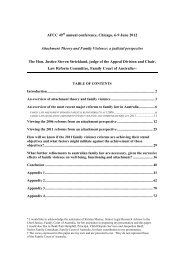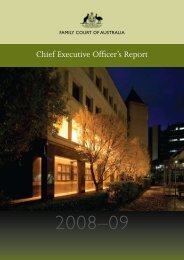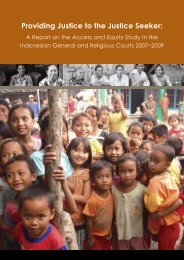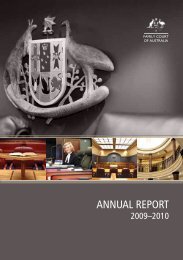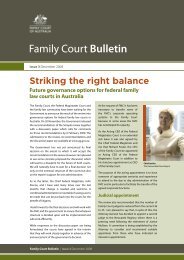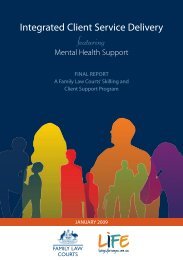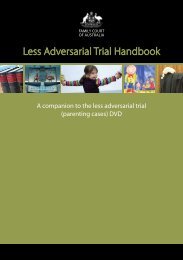pARt 6 MAnAGeMent AnD AccountABilitY - Family Court of Australia
pARt 6 MAnAGeMent AnD AccountABilitY - Family Court of Australia
pARt 6 MAnAGeMent AnD AccountABilitY - Family Court of Australia
- No tags were found...
Create successful ePaper yourself
Turn your PDF publications into a flip-book with our unique Google optimized e-Paper software.
Performance Management and Development SystemThe <strong>Court</strong>s’ Performance Management and Development System aims to align individual outcomes toteam and branch business plans, leading ultimately to achieving the two <strong>Court</strong>s’ visions and businessplans. Participation is mandatory for all employees except probationers. Employees must participate inthe system to be eligible for the salary increases provided under the new Enterprise Agreement and forsalary advancement within their classification scale.Performance management and development provides a framework to develop individual performance toassist an employee to achieve his or her potential. It is a continuous process and imposes responsibilitieson both individual employees and their supervisors/managers. It relies on ongoing and open discussionsto provide clarity on what is expected to be done, how it could or should be done, and to recogniseprogress and achievement against agreed outcomes. It fosters a working environment that values the<strong>Court</strong>’s people, recognises diversity and acknowledges their contribution to organisational success.The target in 2009–10 was for 100 per cent <strong>of</strong> employees participating in the system. This was achieved.Employee assistance programPART 6MANAGEMENT AND ACCOUNTABILITYThe <strong>Court</strong>’s employee assistance program provides a free, confidential counselling service to the judiciary,<strong>Court</strong> employees and their immediate families experiencing personal or work-related problems. Theservice also provides a telephone advisory service for managers.Converge International managed the program and provided generic data to the <strong>Court</strong> to guide thedevelopment <strong>of</strong> wellbeing strategies.Peer support networkThe nature <strong>of</strong> the <strong>Court</strong>’s core business means that employees may be exposed to and involved inhighly sensitive and stressful situations. During 2009–10, the <strong>Court</strong> continued a proactive approach tolessen the risk <strong>of</strong> stress in the workplace by introducing a peer support system within registries and theNational Support Office.The system provides a network <strong>of</strong> trained staff in the workplace to ensure that skilled support is availablefor immediate assistance should an individual experience a distressing situation or difficult event. Thesystem is designed to complement the employee assistance program and allows support to be availableimmediately should an incident occur.Peer support <strong>of</strong>ficers from any location can provide assistance as required, that is, there is no restrictionon staff accessing <strong>of</strong>ficers from outside their immediate work area. All communication with trained peersupport <strong>of</strong>ficers is strictly confidential.Productivity gainsThe first full year <strong>of</strong> the single administrative structure for the <strong>Family</strong> <strong>Court</strong> and the Federal Magistrates<strong>Court</strong> continued to produce efficiency savings through the more efficient allocation <strong>of</strong> resources,elimination <strong>of</strong> duplicated services and the rationalisation <strong>of</strong> court services.Synergies were achieved in the area <strong>of</strong> training where program delivery was made available to the staff<strong>of</strong> both courts, thus reducing cost and capturing a greater number <strong>of</strong> staff.As part <strong>of</strong> the single administration, the review <strong>of</strong> client services and registry management structuresresulted in a number <strong>of</strong> changes being introduced to further reduce duplication, improve the overall126 <strong>Family</strong> <strong>Court</strong> <strong>of</strong> <strong>Australia</strong> — Annual Report 2009–2010



